Potash Corp of Saskatchewan Inc
Latest Potash Corp of Saskatchewan Inc News and Updates
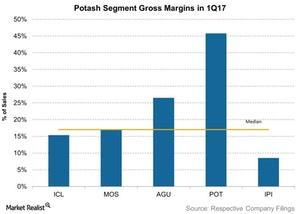
Where Intrepid’s Potash Segment Margin Stands next to Peers
Intrepid Potash’s (IPI) gross margin for its Potash segment swung to positive territory in 1Q17, while its Trio margins were in the negative territory.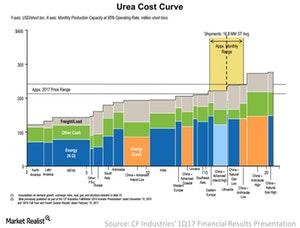
Understanding the Urea Cost Curve for CF Industries
Not only did CF Industries’ earnings fall year-over-year (or YoY) in 1Q17, its margins were also significantly lower YoY. To understand why, let’s dig deeper into the cost curve.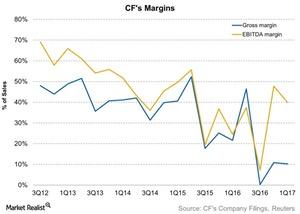
A Review of CF Industries’ Margin Trends
Over the past five years, CF Industries’ (CF) gross and EBITDA (earnings before interest, tax, depreciation, and amortization) margins have contracted.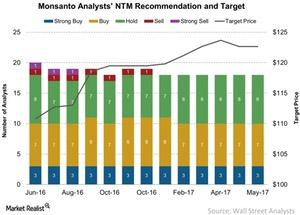
Monsanto’s Price Targets and Recommendations in June 2017
On June 9, Monsanto (MON) stock closed at $117.5 per share.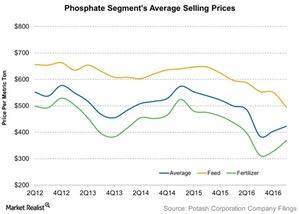
Understanding PotashCorp’s Phosphate Price Dive in 1Q17
PotashCorp’s average realized prices for phosphate fell ~15% to $423 per ton in 1Q17, as compared to $499 per ton in 1Q16.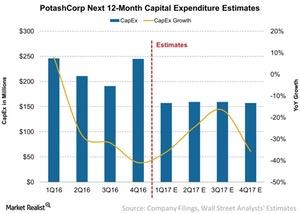
What Analysts Forecast for PotashCorp’s Capital Expenditure
In recent years, agricultural fertilizer companies like PotashCorp (POT), Agrium (AGU), Israel Chemicals (ICL), and CF Industries (CF) have incurred higher capital expenditures.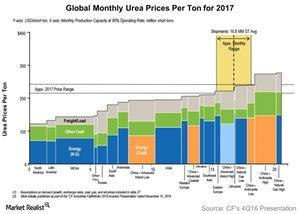
Urea Cost Curve Steepens: What It Means for CF Industries
Urea prices have fallen by an average of 14% annually over the past five years. The consistent fall has been due to falling energy costs, leading to lower production costs across the board.
Nitrogen Producers’ Realized Prices: A Key Comparison
In 4Q16, the average price of ammonia for the five producers in our chart fell by an average of 38%.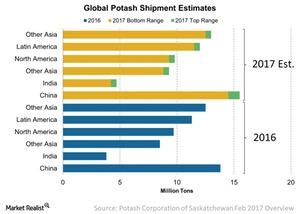
Demand and Supply Outlook for Potash in 2017
According to PotashCorp, the outlook for potash appears positive in 2017. North America, Latin America (especially Brazil), India, and China have been running low on inventory.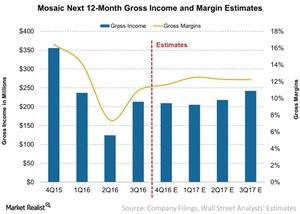
What Do Analysts Expect for Mosaic’s 4Q16 Gross Margin?
Wall Street analysts estimate that Mosaic (MOS) could report gross income of $209 million, which represents a 41% year-over-year fall from $355 million in 4Q15.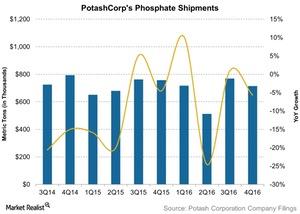
How PotashCorp’s Phosphate Shipments Performed in 4Q16
Overall shipments for PotashCorp’s Phosphate segment fell 6.0% in 4Q16 to 0.72 million tons, from $0.76 million tons in 4Q15.
PotashCorp in 4Q16: Nitrogen Prices Added Salt to the Wound
In 4Q16, the overall average nitrogen selling price fell 37.0% to $182 per ton, from $288 per ton in 4Q15.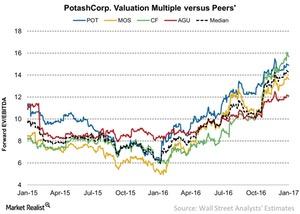
Comparing PotashCorp’s Enterprise Multiple with Its Peers
PotashCorp (POT), which is currently trading at an EV-t0-EBITDA multiple of 15.0x, is trading far above its low point of 6.0x a year ago.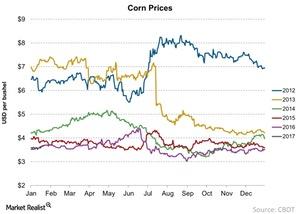
Why Corn Prices Moved Higher in January
Global corn prices are significantly lower than they’ve been for the past four years, considering the high global corn stock-to-use ratio last year.
Potash Fertilizer Cost Drivers and Production Flow
Potash salts are the key cost of production for potash, so most producers have an integrated production.
Phosphate Fertilizer Cost Drivers and Production Flow
Since phosphate rock is one of the major costs of production, companies such as Mosaic (MOS) have an integrated production process.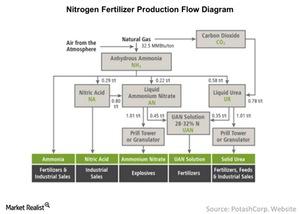
A Look at Nitrogen Fertilizer Cost Drivers and Production Flow
Energy as well as freight and handling can be the two biggest costs for nitrogen fertilizer production.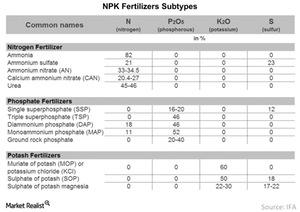
The Most Common NPK Fertilizers: Why Combinations Are Important
Fertilizers are commonly labeled using a convention that includes the amount of NPK available in the mix.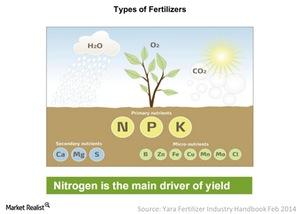
Breaking Down Types of Key Fertilizers Used Today
There’s a constant need to bring up the fertility levels necessary to grow crops, and that need is fulfilled by fertilizers.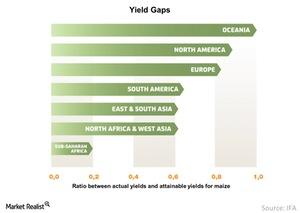
Fertilizers: A Key Part of Increasing Crop Yields
Increasing crop yield on available farmland could be the best solution to the problem of increasing crop production.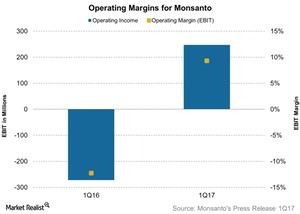
Why Monsanto’s Operating Margins Improved in 1Q17
Monsanto reported operating income or EBIT of $247 million, which rose from -$272 million in fiscal 1Q16.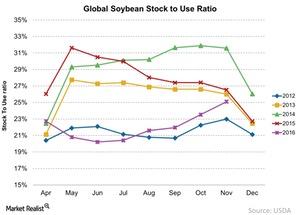
Inside the Soybean Inventory Rise in December
The global soybean stock-to-use ratio for soybeans rose to ~25.1% in December 2016, as compared to 24.8% in November 2016.
What Were Potash Companies’ 3Q16 Realized Prices?
Potash’s selling price has been on the decline for the last few quarters and is key to the performances of potash producers (NANR).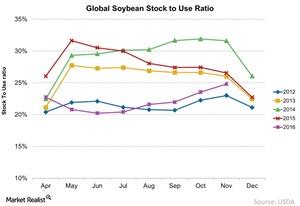
Soybean’s Stock-to-Use Ratio Rose with the Inventory
Unlike corn, the global soybean stock-to-use ratio is lower compared to the global stock-to-use ratio of 26.5% last year.
Mosaic’s Phosphate Shipments Will Likely Rise
The Phosphate segment’s shipments rose 23% to ~2.5 million tons from ~2 million tons in 3Q15—compared to guidance of 2.4 million–2.7 million tons.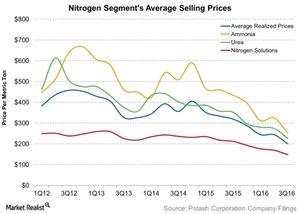
Why Did PotashCorp’s Nitrogen Prices Fall in 3Q16?
Nitrogen selling prices PotashCorp (POT) sells nitrogen fertilizers such as ammonia, urea, and nitrogen solutions. It competes with other natural gas–based nitrogen producers such as CF Industries (CF) and Terra Nitrogen (TNH), which primarily produce and sell nitrogen fertilizers. Agrium (AGU), which is a part of the PowerShares International Dividend Achievers ETF (PID), produces nitrogen fertilizers […]
Soybean’s Stock-to-Use Ratio Rose in October
The global stock-to-use ratio for soybeans rose 1.6% to ~23.5% in October—compared to 22% in September. Soybean’s ratio is lower than last year.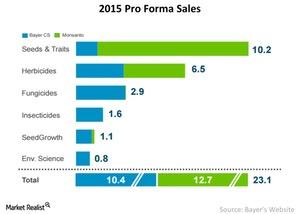
Synergies Monsanto and Bayer Could Exploit through a Merger
Monsanto’s business is the best fit for Bayer’s Crop Science segment—it contributes ~22% of Bayer’s revenue. The segment is similar to Monsanto’s business.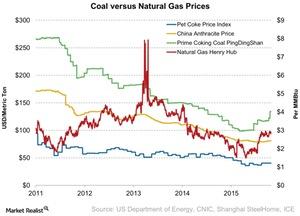
Weekly Nitrogen Update: Anthracite Prices Fell in China
For the week ending September 9, average weekly anthracite coal prices in China fell 4.2% to $81.1 per metric ton—compared to the previous week.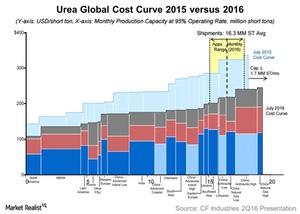
Why Nitrogen Prices Have Fallen So Hard this Year
The global nitrogen fertilizer capacity is abundant, allowing it to fulfill the current market requirements. This has put pressure on nitrogen prices, which fell significantly over the past year.
Pet Coke and Coal Prices Moved Sideways Last Week
While most North American producers use natural gas to produce nitrogen fertilizers, CVR Partners (UAN) mainly uses pet coke as a hydrogen source.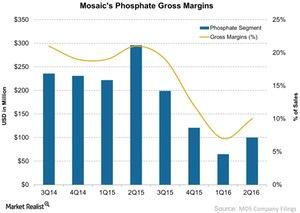
Why Have Mosaic’s Potash Shipments Declined?
The gross margin rate for Mosaic’s Phosphate segment fell significantly in 2Q16, to 10% from 21% in 2Q15.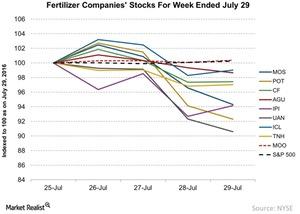
Which Fertilizer Stock Was the Top Loser Due to Price Movements?
Fertilizer prices are one of the key drivers for fertilizer stocks. So investors and analysts watch fertilizer prices closely.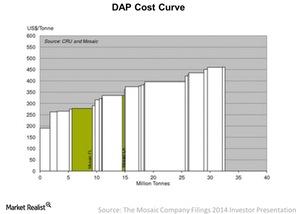
How DAP- and MAP-Producing Countries Stack Up on the Cost Curve
In 2014, the cost of production for DAP per ton ranged from $190 to $450 per metric ton, as we can see in the chart.
Phosphate Consumption Outlook and Top Producers to Serve the Market
The Mosaic Company (MOS), which acquired CF Industries’s (CF) phosphate business in 2014, is the largest producer of phosphate globally.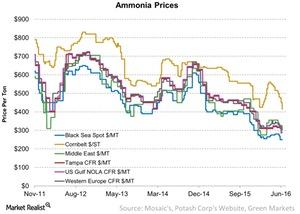
Why Do Ammonia Prices Keep Falling?
Ammonia prices in the Southern Plains had the steepest fall of 10.5% last week, continuing the previous week’s trend.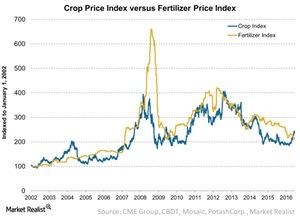
Agricultural Chemical Companies: Crop and Fertilizer Price Impact
Investors in the fertilizer industry (XLB) must actively track the relationship between crop prices and fertilizer prices. This, in turn, impacts agricultural chemical companies.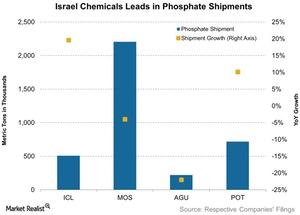
How Phosphate Shipments Performed in 1Q16
Israel Chemicals, which shipped 0.5 million metric tons during the recent quarter, saw the largest jump in shipment growth—20% year-over-year.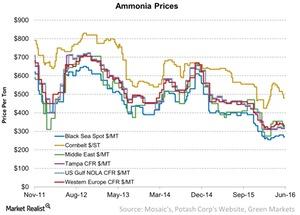
How Did Ammonia Prices Move Last Week?
Last week, nitrogen producers CF Industries (CF), CVR Partners (UAN), Terra Nitrogen (TNH), and PotashCorp (POT) ended in the red.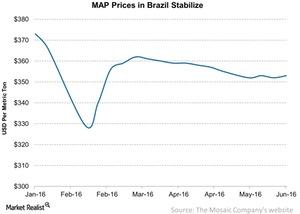
Why MAP Fertilizer Prices Continue to Stabilize
Last, average MAP prices in Brazil inched up to $353 per metric ton from $352 per metric ton the previous week.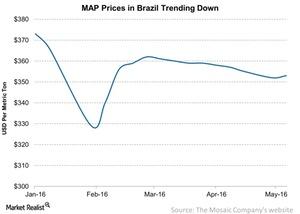
Ammonium Phosphate Prices: A Comparison
MAP (monoammonium phosphate) is the second-most used phosphate fertilizer after DAP (diammonium phosphate).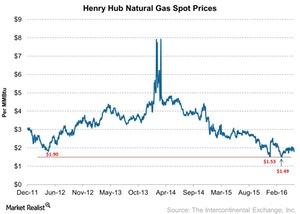
How Do Natural Gas Price Forecasts Impact Fertilizer Companies?
Natural gas is the key raw material for the production of nitrogen fertilizers such as ammonia and urea.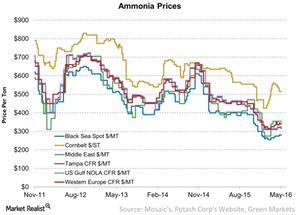
How Did Ammonia Prices Trend Last Week?
Ammonia prices for Tampa CFR (cost and freight) moved down 1.6% to $315 per metric ton compared to $320 per metric ton in the previous week.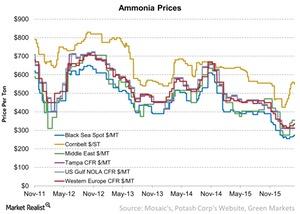
Ammonia Prices in the International Market Inch Up
In the international market, ammonia at the Black Sea, Ukraine, inched up to $275 per metric ton FOB, a rise of 1.9% from the previous week.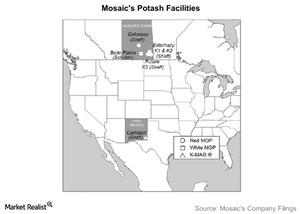
An Overview of Mosaic’s Potash Segment Operations
Mosaic’s Potash segment generated $2.5 billion in net sales, excluding intersegment sales, in 2015. This accounted for 28% of the company’s total net sales.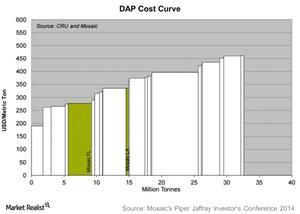
Where Does Mosaic Stand on the Cost Curve for Its Fertilizers?
Fertilizer prices and input costs affect all players in the industry. Survival and profitability come down to where a company stands on the cost curve.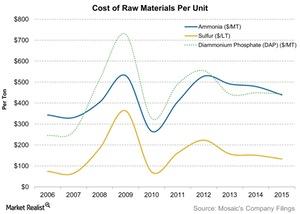
How Has Mosaic Done in Terms of Raw Material Costs?
Mosaic purchases certain raw materials at fixed costs to be consumed over time, but the selling prices of its finished goods can fluctuate rapidly.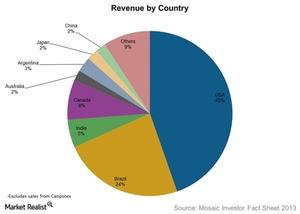
Who Are Mosaic’s Customers and How Does It Reach Them?
Mosaic doesn’t sell directly to farmers. Its customers include cooperatives, wholesale distributors, retail chains, and independent retailers.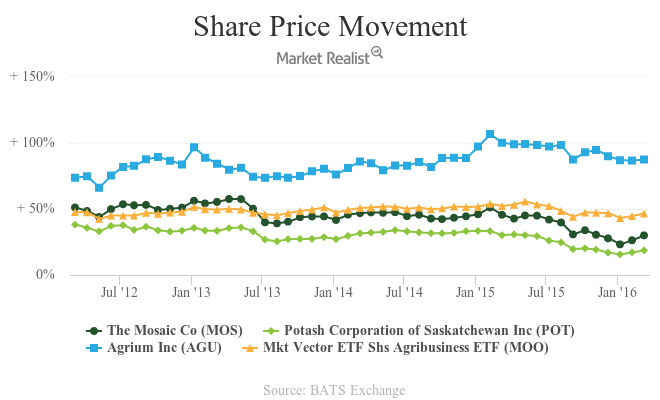
How Phosphate Fertilizer Prices Are Changing Trends
In the 2010–2011 planting season, phosphate fertilizers accounted for about 23% of total NPK fertilizers consumed globally.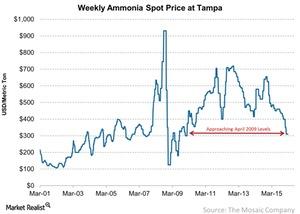
Ammonia Prices Fell Slightly from the Previous Week
Ammonia was trading at $310 per metric ton as of the week ending March 4, 2016. It fell $1 from the previous week ending February 26, 2016.
